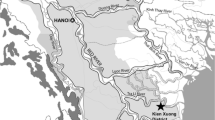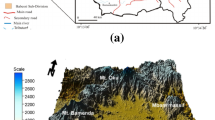Abstract
Risk can be seen as both objective, quantifiable, and subjective, constructed at an individual level. This paper focuses on the latter and aims to explore flood perceptions in relation to socio-demographic variables and various economic measures. The data were drawn from four villages on the banks of the Danube using quantitative questionnaires, villages data sheet and in-depth semi-structured interviews. This mixed method approach allowed for ecologically sound findings. Inequality of income and capital are linked with variations of some risk perception dimensions such as disaster temporal proximity, perceived resilience, and also with a reluctance to think about the future and the dangers it might pose. Past floods are associated with most dimensions tested, including income, inequality, and whether the next flood appears to be imminent. Lower-income households expect some form of assistance not from the community, the church, or local authorities, but from the government. This highlights erosion of social values, or inter-household monetisation, as the other major issue, alongside inequality, faced by rural populations living on the banks of one of Europe’s greatest rivers.




Similar content being viewed by others
References
Armaş I (2006a) Evaluarea percepţiei în studii de risc: centrul istoric al oraşului Bucureşti, Anchetă 2005. Comunicari de Geografie, vol 10 (pp 507–517, fig. 3)
Armaş, I. (2006b), Percepţia riscului seismic în Bucureşti, pe baza anchetei din 2000, An. Univ. Spiru Haret, 9. (p. 131-137)
Armaş I (2007) Earthquake risk perception in Bucharest, Romania. Risk Anal 26(5):1223–1234
Armaş I (2008a) Social vulnerability and seismic risk perception. Case study: the Historic Center of The Bucharest Municipality/Romania. Nat Hazards 47(3):397–410
Armaş I (2008b) Percepţiariscului natural: cutremure, inundaţii, alunecări de teren. Editura Univ. din Bucuresti, Bucureşti
Armaş I, Avram E (2008a) Patterns and trends in the perception of the seismic risk. Case study: Bucharest Municipality/Romania. Nat Hazards 44(1):147–161
Armaş I, Avram E (2008b) Tendencies in seismic risk perception in Bucharest (2000–2006). Psychol Thought 3(5):22–39
Armaş I, Avram E (2009) Perception of flood-risk in Danube Delta, Romania. Perception of flood risk in Danube Delta, Romania. Nat Hazards 50:269–287
Beck U (1986, 1992) Risk society—towards a new modernity (trans: Ritter M). Sage Publications, Los Angeles
Birkholz S, Muro M, Jeffrey P, Smith HM (2014) Rethinking the relationship between flood risk perception and flood management. Sci Total Environ 478:12–20
Botzan M, Haret M, Stanciu I, Visinescu I, Buhociu L (1991) Valorificarea hidroameliorativa a Luncii Dunarii Romanesti si a Deltei. Centrul de Material Didactic si Propaganda Agricola, Bucuresti
Brehmer B (1987) The psychology of risk. In: Singleton WT, Hovden J (eds) Risk and decisions. Wiley, New York, pp 25–39
Bubeck P, Botzen WJW, Aerts JCJH (2012) A review of risk perceptions and other factor that influence flood mitigation behavior. Risk Anal 32:1481–1495
Burton C, Cutter S (2008) Levee failures and social vulnerability in the Sacramento-San Joaquin Delta Area, California. Nat Hazards Rev 9 (Special issue: Flooding in the Central Valley):136–149
Cutter S, Boruff B, Shirley LW (2003) Social vulnerability to environmental hazards. Soc Sci Q 84(2):2003
Davidson DJ, Freudenburg G (1996) Gender and environmental concerns: a review and analysis of available research. Environ Behav 28:302–339
Drottz-Sjöberg B-M (1991) Perception of risk. Studies of risk attitudes, perceptions and definitions. Stockholm School of Economics, Center for Risk Research, Stockholm
Fekete A (2012) Spatial disaster vulnerability and risk assessments: challenges in their quality and acceptance. Nat Hazards 61(3):1161–1178. doi:10.1007/s11069-011-9973-7
Felsenstein D, Lichter M (2014) Social and economic vulnerability of coastal communities to sea-level rise and extreme flooding. Nat Hazards 71(1):463–491
Fischhoff B, Slovic P, Lichtenstein S, Read S, Combs B (1978) How safe is safe enough? A psychometric study of attitudes towards technological risks and benefits. Policy Sci 9(2):127–152
Flynn J, Slovic P, Mertz CK (1994) Gender, race, and perception of environmental health risks. Risk Anal 14(6):1101–1108
Fordham M (2000) The place of gender in earthquake vulnerability and mitigation. In: Second Euro conference on global change and catastrophic risk management—earthquake risks in Europe, Austria. Laxenburg, Austria
Freedy J, Hobfoll S, Ribbe D (1994) Life events, war and adjustment: lessons for the middle east. Anxiety Stress Coping 7:191–203
Gardner SJ, Dekens J (2007) Mountain hazards and the resilience of social–ecological systems: lessons learned in India and Canada. Nat Hazards 41:317–336
Gustafson PE (1998) Gender differences in risk perception: theoretical and methodological perspectives. Risk Anal 18(6):805–811
Harries T (2008) Feeling secure or being secure? Why it can seem better not to protect yourself against a natural hazard. Health Risk Soc 10(5):479–490
Harries T (2012) The anticipated emotional consequences of adaptive behaviour—impacts on the take-up of household flood-protection protective measures. Environ Plan A 44(3):649–668
Institutul National de Statistica—TEMPO on line. https://statistici.insse.ro
Kelman I (2007) Reliance on structural approaches increases disaster risk, Version 1, 26 July 2007. Downloaded on 20 December 2014 from http://www.ilankelman.org/miscellany/StructuralDefences.rtf
Kousky C, Kunreuther H (2009). Improving flood insurance and flood risk management: insights from St. Louis, Missouri. Resources for the Future. February 2009. RFF DP 09-07. www.rff.org
Lindell MK, Perry RW (2000) Household adjustment to earthquake hazard: a review of research. Environ Behav 32(4):461–501
Ludy J, Kondolf GM (2012) Flood risk perception on lands ‘protected’ by 100-year Levees. Nat Hazards. doi:10.1007/s11069-011-0072-6
Luhmann N (1991) Risk: a sociological theory. de Gruyter, Berlin
Luhmann N (1993) Soziologische Aufklärung 5: Konstruktivistische Perspektiven. Westdeutscher Verlag, Opladen
Mandelbrot BB, Hudson RL (2004) The (mis) behaviour of financial markets: a fractal view of risk, ruin, and reward. Basic Books, New York
Marris C, Simpson A, O’Riordan T (1995) Redefining the cultural context of risk perceptions. In paper presented at the 1995 annual meeting of the Society for Risk Analysis (Europe), Stuttgart, University of East Anglia, Norwich
NumXL (2014) Descriptive statistics. GINI (Pro.). http://www.spiderfinancial.com/support/documentation/numxl/reference-manual/descriptive-stats/gini
Piketty T (2014) Capital in the twenty-first century. The Belknap Press of Harvard University Press, Cambridge
Renn O (1989) Risikowahrnehmung: PsychologischeDeterminantenbei der intuitivenErfassung und Bewertung von technischenRisiken. In: Hosemann G (ed) Risiko in der Industriegesellschaft. Erlangen Universitätsbibliotheksverlag, 167–191
Renn O (2008) Risk governance. Coping with uncertainty in a complex world. Earthscan, London
Rohrmann B (1995) Risk perception research: review and documentation, programme group men, environment, technology. KFA Research Centre, Julich
Schwarz A-M, Béné C, Bennett G, Boso D, Hilly Z, Paul C et al (2011) Vulnerability and resilience of remote rural communities to shocks and global changes: empirical analysis from Solomon Islands. Glob Environ Change 21(3):1128–1140. doi:10.1016/j.gloenvcha.2011.04.011
Sjöberg L (1979) Strength of belief and risk. Policy Sci 11:39–57
Sjöberg L (1994) Perceived risk vs demand for risk reduction (Rhizikon: Risk Research Report No. 18). Center for Risk Research, Stockholm School of Economics
Slovic P (1992) Perception of risk: reflections on the psychometric paradigm. In: Krimsky S, Golding D (eds) Social theories of risk. Praeger, Westport, pp 117–152
Steinberg T (2000) Acts of God—on the unnatural history of natural disasters in America. Oxford University Press, Oxford
Suar D, Mandal MK, Khuntia R (2002) Supercyclone in Orissa: an assessment of psychological status of survivors. J Trauma Stress 15(4):313–319
Thurstone LL (1928) Attitudes can be measured. Am J Sociol 33:529–554
Tobin GA (1995) The Levee love affair: a stormy relationship. Water Resour Bull 31(3):359–367
Tunstall T, Tapsell S, Green C, Floyd P, George C (2006) The health effects of flooding: social research results from England and Wales. J Water Health 04(3):365–380. doi:10.2166/wh.2006.031
Tversky A, Kahneman D (1974) Judgment under uncertainty: heuristics and biases. Science 185:1124–1131
United Nations (2006) Inequality analysis the Gini Index. Food and Agriculture Organization of the United Nations, FAO. Available online at http://www.fao.org/docs/up/easypol/329/gini_index_040en.pdf
Zaalberg R, Midden C, Meijnders A, McCalley T (2009) Prevention, adaptation, and threat denial: flooding experiences in the Netherlands. Risk Anal 29(12)
Acknowledgments
The research for this paper was made under the framework of ‘Taming the Post-socialist nature: floods, local strategies and national policies along the Lower Danube’ (PN-II-ID-PCE-2012-4-0587), a project funded by UEFISCDI—http://uefiscdi.gov.ro/ This work was also supported by the strategic Grant POSDRU/159/1.5/S/133391, Project ‘Doctoral and Post-doctoral programs of excellence for highly qualified human resources training for research in the field of Life sciences, Environment and Earth Science’ cofinanced by the “European Social Found within the Sectorial Operational Program Human Resources Development 2007–2013”.
Author information
Authors and Affiliations
Corresponding author
Rights and permissions
About this article
Cite this article
Armas, I., Ionescu, R. & Posner, C.N. Flood risk perception along the Lower Danube river, Romania. Nat Hazards 79, 1913–1931 (2015). https://doi.org/10.1007/s11069-015-1939-8
Received:
Accepted:
Published:
Issue Date:
DOI: https://doi.org/10.1007/s11069-015-1939-8




